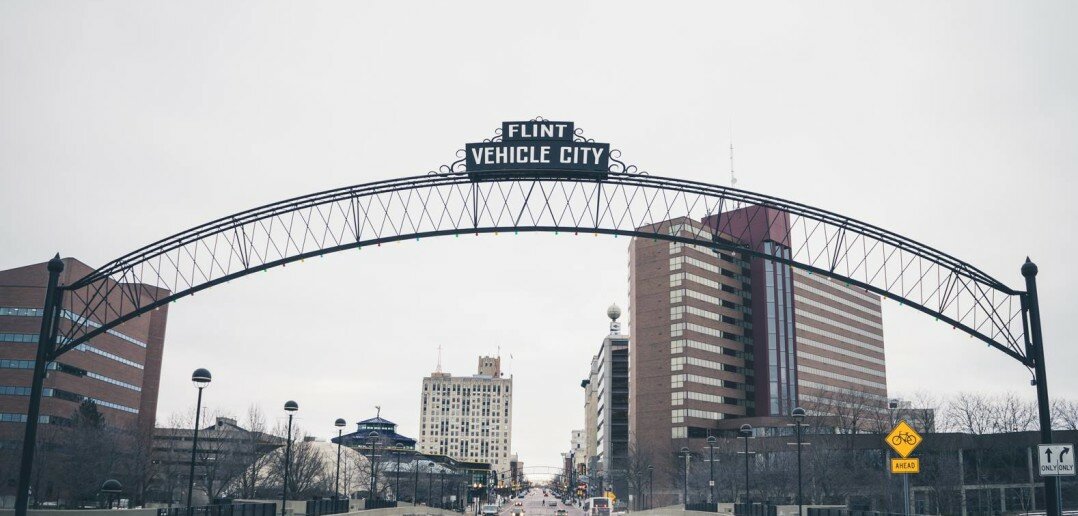“Build With Me, Family”
My fraternity brother Jaquan Yawn (Jay) hit me on a Monday in early January, inviting me to collaborate with him. Taking seriously my responsibility in stimulating the culture here in Columbus and open to any new ways to complete my mission, I took him up on his offer without much more up-front information. “Build with me, Family,” was how he started the conversation started. I’d come to find out after talking to him more, he was concerned about the news coming out of the state up north. “I don’t know what to do, but I just feel like I need to do something.”

It’s 2016 and the city of Flint, Michigan, population 99,000, is in a state of emergency. The pipelines responsible for bringing clean water to the city’s residents have corroded to such a point that lead traces are found in every glass. Decisions made in early 2014 to switch the city’s drinking water source to the contaminated Flint River set off a chain of events that have changed some lives forever. The heavily polluted water would come to erode the walls of the city’s plumbing and soon every drop of water falling from taps across Flint was poisoned.
All Eyes On Flint
We’re both mid-westerners, me being a native of Columbus and Jay of Cleveland. “This could happen to anybody,” he reminded me as I questioned him on if we were possibly taking the crisis to serious. The damaging effects of lead poisoning are documented well enough that I’m not going to go into details about how bad it is, here. Summarily, lead intake over an extended period of time, especially in children, will lead to long-term, irreversible damage which is why people are strongly encouraged to avoid it.
The story of Flint went viral near the turn of the year. Since fundraising efforts have sprung up across the country. Celebrities made headlines donating thousands of cases of water. Politicians nationwide pontificated against the corruption that seemed to take root in the Great Lake state. Scores of Americans took to their social media channels to express their outrage with the dereliction of duty by the state government.
America, 2016.
For Jay, it was important to put boots on the ground. “I don’t trust the relief efforts. I remember Katrina.” After some guerrilla organizing, four of us made the first trip to Michigan with a Suburban filled to the roof with hundred cases of water to deliver door to door. Once in the state, we linked with two Flint natives and another member of our fraternity who resided in Detroit.

Before starting the mission, we broke bread and I asked questions about what the sentiment of the city was. Their responses made my heart sink. “Is he (Governor Rich Snyder) Hitler? I don’t know,” one of the locals remarked to me. That was before he started to wonder aloud if the poisoning had been intentional. He casually commented about population control and pondered on if purposeful neglect could qualify as genocide. This did not feel a conversation that could happen in America.
I left Flint that weekend changed. I hugged my daughter extra tight when I got back to Columbus with a renewed appreciation for life and love. A day after our excursion, the pictures were published on Facebook and our communities learned about the trip we’d taken. Just a few days later, Jay told me he was going back the next weekend. I couldn’t make it because of other commitments, but I sent my associate editor Jenna Tay on behalf of the FlyPaper Team. The following is her experience.
-Malcolm White
(Pictures from the first trip to Flint)
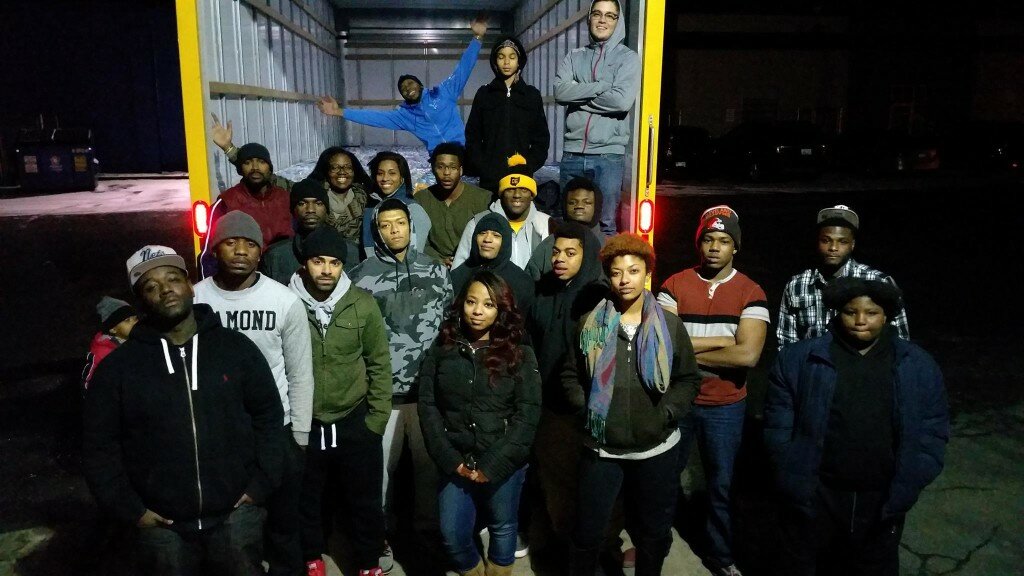
The Drive
Waking at four in the morning doesn’t entail my typical Saturday morning. Around this hour is when I can typically be found barefoot on my block, high heels in hand, with a stomach full of waffles and smothered hash browns thinking of how epic the upcoming episode of sleep will be. But today would be different, I had been invited to Flint, Michigan to shadow a group of young givers, doers, and dreamers to distribute bottled water. A city that constantly stars in news headlines for its’ lack of safety, population, economy thereof, and most recently its’ access to the clean natural resource-water.
Our twelve man caravan packed into three SUV’s, two sedans, and two Penske moving trucks at 6:00 am. I was to ride with Jaquan Yawn, [founder]Trevion Blanding’s collaborative partner who helped to inspire #Columbus4Flint and a true example of the stereotype that men don’t follow directions. There was also his significant other Bri Lynem, who’s persona tops my list of the sweetest individuals I’d come across in my short twenty four years of life.
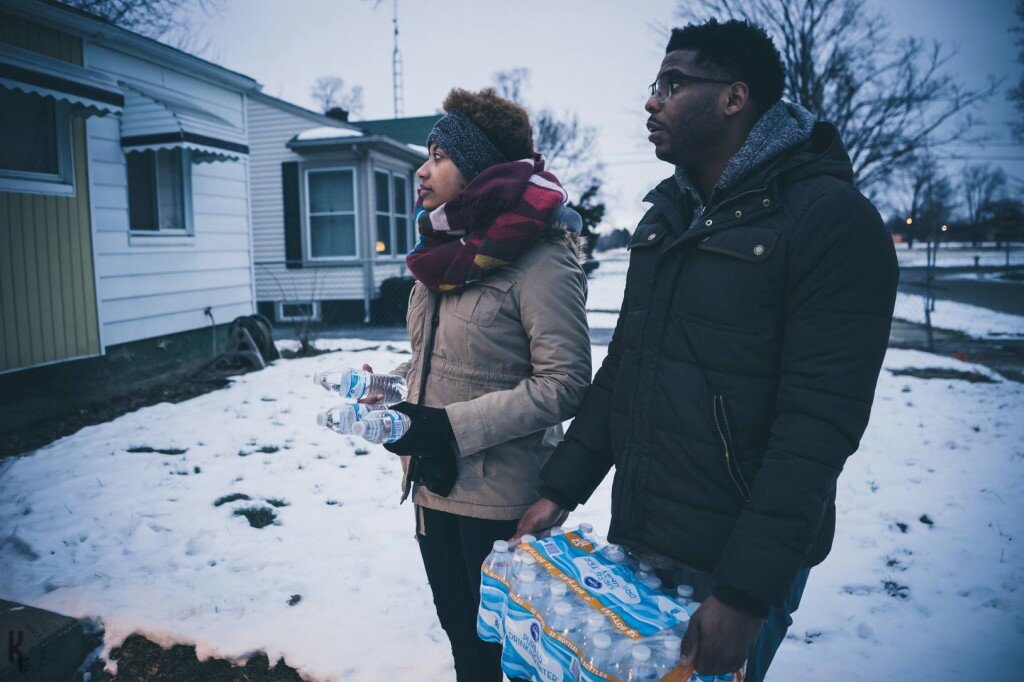
The four hour drive crawled at 55 mph, ironically painted in billboards advertising clean water solutions and reputable plumbing companies. It was typical Ohio-Michigan scenery, nothing special to see, and the only thing that could remedy the drive would be like minded conversation which eventually turned into philosophical rants over whether Post Malone represented modern day appropriation- at some point I had somehow drifted off to sleep. Jay’s driving is best summarized as a sequence of last minute swerves, jarring brakes and last minute decision making but I managed sleep until we exited the interstate.
Before reaching the streets of Flint I was to meet Trevion, founder of #Columbus4Flint and the rest of my volunteering crew. Today had marked the groups’ first official distribution (and second ever trip) as #Columbus4Flint and a first in Flint for myself. Trevion, no more than 6’3 and shaded in brown skin, seemed giddy, a natural spirit that he couldn’t help but to hide under his bundle of mismatch layers. He was anxious to help and the fact that his group had managed to compile over 1,000 cases of bottled water from various donors created no effort to ease his adrenaline. Trevion and his family are natives of Flint, they’re roots date back to the 1950’s and have since scattered throughout St. Louis, Arkansas, and the Carolinas though many still remain in Flint today.
Trevion continued his introductions: there was his cousin Demarian Chapman who had generously volunteered out of sheer activism to act as our tour guide; his bright eyed sister Quanice Shumpert (who challenged the depth of my shyness with continuous conversation and engagement); his mother and step father who smile proudly throughout the day; and later, I was to meet Maurell Chapman, Demarian’s brother who would help us navigate the streets (he too added the water crisis to his personal agenda). Activism ran through the blood of the family.
The Poverty and Proud Memory Of Flint
Through collaboration a list of addresses was compiled, mainly those of family member and recommendations from residents of Flint’s most impoverished areas. The initial plan was to distribute two cases of water to every address on the list and then distribute the remaining cases at the untouched homes.
As we drove along Pierson Avenue to the first neighborhood, I couldn’t help but to notice the absence of people, housing, and crime infestation that seemed to fill the conversations (or lack thereof) of talking heads in the news. What WAS prevalent in Flint were neighboring churches of varying denominations. The churches lined up parallel to corner stores that not only sold meats, but also pawned jewelry, officially retailed Boost Mobile, advertised COORS Light at 89 cents a can and accepted EBT. The uncanny assortment existed in the residential parts of towns as well. Blue collar neighborhood featured well-kept homes right next to abandoned boarded shacks and condemned properties that had yet to be demolished. Flint is a clear example of exploitation of the poor, working class, and the elderly.
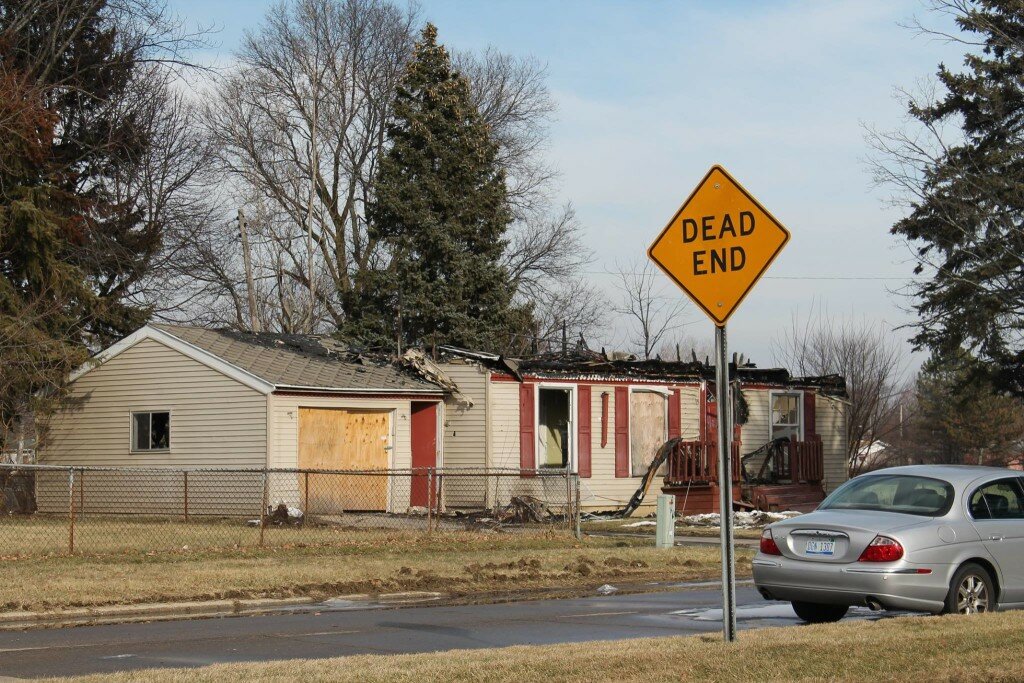
Many of us our know Flint as the original home of General Motors. But ever since Flint’s deindustrialization in the late 1980’s, population data from the U.S Census has shown a drastic decrease in total population over the years. In 1980 it was measured that 450,449 people resided Genessee County [Flint], but by 2010 the Census only accounted for 102,400 residents. Today it is estimated that less than 99,763 residents remain in Flint today.
Flint is also a food desert. In the beginning of 2015 grocery giants Meijer and Kroger closed their doors’ completely ‘eliminating a sense of convenience’ as Demarian explained it to me. Those affected are now forced to go 5-7 miles west to Landmark Food Center, a small grocery chain that provides general grocery items. Other than Landmark there is also Farmer’s Market, an open market with 50 vendors comparable to that of the North Market located in downtown Columbus. But like the North Market operating hours are generally inaccessible. On Tuesday- Thursday the market is open from 9:00am-5:00pm and 8:00-5:00 pm on Saturdays. Residents mainly rely on the consolidated corner stores which tend to carry basic grocery items such as milk, bread, eggs, deli meats and plenty of beer and liquor.
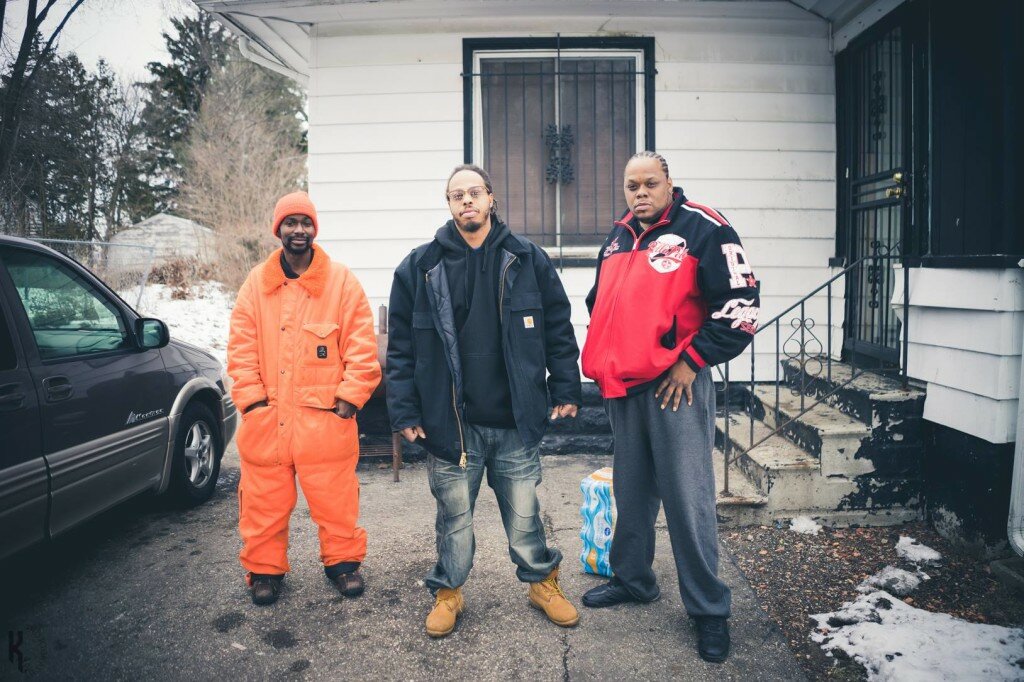
Public education is provided by Flint Community Schools in which eleven elementary and two high schools accommodate just under than 30,000 students. In the 2013-2014 school year the entire district achieved marks no higher than 22% as measured by Michigan’s Top-to-Bottom school accountability system which ranks schools on their student performance in math, reading, writing, science, and social studies, and high school graduation rate.
Flint is deep in the abyss of generational poverty and I cannot break it down better than Trevion explained to me. To him Flint needs better education, more businesses, in turn creating more jobs. “When you don’t have these thriving characteristics in an economy there is no hope. They are the basics to build a life that includes financial stability. Whenever you take away another school, or roads don’t get fixed, and there aren’t any viable means of transportation there is no opportunity, and in my opinion a lot of people who stay in Flint don’t end up doing much of anything because of that.” stated Trevion.
The Crisis Epiphany
Trevion made sense, and as we arrived in our first neighborhood on the north side I spotted an elderly man who had just pulled in his driveway from the store. In his truck were cases of water that tiled the flatbed of his truck. Suddenly, the scenes that I’d watched comfortably on the 46” inch television in my living room, were right in front of me. This was not recreational visit or a opportunity to pat myself on the back for doing some good “service”. This man and all of the residents in the city were in crisis. For me, it was finally real.
We split up into groups of two and three knocking door to door distributing two cases of water per home, though if we identified a severe need, more could be given. Those who answered their door looked all too much of the same. The majority were black, mainly elderly, some with young children in the home, and some alone, but all of which were grateful for the bottled water.
Well into an hour of knocking on doors I could feel a sense of repulsion growing inside my stomach, and with every thanks I received the nausea only grew worse. It was hard to fathom that offering bottled water could bring the same sense of comfort to a face as if I’d prepared them a home cooked meal. Before visiting Flint I obliviously thought of clean water as a God-given right, a natural freedom of some sorts, but water let alone clean water is no longer free in the land of the alleged free.

Despite the fact that Flint’s water remains contaminated due to the city’s corroded piping, residents are still responsible for paying for their water bills. Since 2014 the City of Flint has gone back and forth between sourcing its’ water from the contaminated Flint River and Detroit’s water supply. Today the water sources from Detroit’s supply which has only tripled the cost of water; on average most residents are billed at $140 per month. According to Jay those with children who are fairly behind on paying the utility are being reprimanded by Children Protective Services.
“There’s a Michigan law that basically states to have a child in the home there must be running water. Even given the water security issue and bills being doubled, even tripled, residents are still expected to pay water bills on time. When I originally came to Flint a lady showed us a $600 water bill despite the fact that she still has to stand in line for clean water. Now many people are being deterred from standing in line at government sites because they have to show ID.
“There is so much mistrust between Flint’s government and residents; but I don’t blame them. Even now the filters given out by the government just so happen to be problematic.” Jay explained.
At 4:00pm with over 100 cases of water and only two hours until sunset the need to efficiently strategize became urgent. We started at the family church but after 45 minutes it became apparent that the church’s location wasn’t the most effective.
#Columbus4Flint
The reason so many grassroots movements fail at an early age is due to strong leadership and a transparent system of communication. The advantage that #Columbus4Flint has over its’ freshly organized peers, is in fact its leadership. There is Jay, a natural born organizer and Trevion’s conscience ability to represent #Columbus4Flint in front of any board. Quanice’s adamant strong personality is able to attract and enlist volunteers, and Scooter and Maurell’s understanding of Flint culture and society, tied in with their drive and willingness to revitalize Flint will help the group to succeed. What also exists is an unspoken climate of trust that was born at day one.

Because of this, leadership was able to make an executive decision to relocate to Hollywood Plaza, one of the busiest commercial plazas remaining in Flint. Words cannot depict what happened as we opened up the trailer of the Penske moving truck, and one car after the other began to literally loop around us all. Unconsciously we had formed an assembly line where three cars would pull forward with one or two people packing cases of water in each car. This was pure unadulterated beauty; us blindly giving, and the recipients open heartedly receiving. Within 30 minutes and a dark sky full of stars and streetlights our truck was finally empty.
#Columbus4Flint will continue distributing water to Flint, until the need is no longer. The group will undergo a few natural initial changes in terms of logistics, volunteer recruitment, and corporate partnerships. There was also mention of adding care packages with items such as hand sanitizer, Lysol wipes, paper ware, and hygiene items to the distribution list.
Redefine your definition of home.
Leaving Flint left me feeling helpless and I couldn’t help but to wonder if others in the group felt the same. Though we were there to lend a helping hand the problem still exist without any viable solutions for the present and future.
The bottles of water distributed were nonetheless a temporary fix, and will in the end evolve into a waste problem. There’s an understood ethos in the US military that states ‘no solider left behind’ yet the American government has clearly left Flint for its’ death. Twenty years from now Flint may be no more than an abandoned ghost town that only those who witnessed its’ existence will be able to identify.
Michigan is our neighbor and lead contaminated water has already been spotted in Sebring, Ohio.
“Redefine your definition of home,” as Jay put it.
“Ask yourself what can we all do to help? What burden can we bear that is not ours? We all drink from the same well that we didn’t dig, so why is it so hard to give a fuck about something that doesn’t directly impact us yet?” Jay explained to me for his reasoning in choosing to help Flint, and as I think about my experience is the reason we choose to publish this article. See your reflection in others and think how your skillset can benefit another in need.
-Jenna Tay
For pictures of the second trip to Flint, click here.
Jay and the #Columbus4Flint movement are currently in the midst of planning a third trip to Flint during the month of March. Stay tuned to FlyPaper Magazine for more information on how you can show your support for Flint and the Relief Effort.

